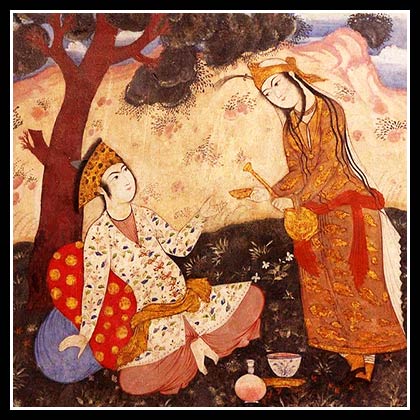About Principles of design and drawing in miniature Iranian painting.
The method and style of drawing and painting in Iranian miniature:

In the past, Iranian designers and painters visualized image of paintings and often illustrated ancient books and legends in the same method.
The hand of an Iranian painter and designer artist, gently draws circles and arcs, also changes the line delicately by rotating the tip of the pen, in the same way as in calligraphy which is called Qalamgiri technique.
The Iranian painter changes the thickness of the lines in the painting by twisting the pen, the repetition of this action creates a bright shadow and volume in the image of the objects. Given the Persian miniature artist special spirit, they always drew with serenity and calmness.
According to some researches, Persian calligraphy appears to be a calm, slippery and orderly line that rotates the curves and uses the wide edge of the pen which creates a special variety and beauty to the Persian script.
The design and style of Persian miniature is also a continuation of the art of Persian calligraphy. Since the Persian painters have also been sophisticated calligraphers, that have used the Qalamgiri technique in Persian pattern and miniature.
Also, Persian style painting has always been in line with Iranian literature throughout history and has somehow served the literature.
On the one hand, Persian miniature enriches with treasure of Iranian literature and on the other hand, it tangles with the artist’s imaginary mind and world. So, that is why the Iranian painter and miniaturist attempts to visualize the imaginary world, hence painter first visualizes and then designs its subject in perfect beauty without any defect or imperfection.
Important points about Persian miniature and painting:
The main features in the art of Iranian miniature and of course Eastern designs are using curved lines, lack of volume, distance and proximity of objects which indeed distinguishes Persian paintings from western painting.
In general, the differences between Iranian and Western painting can be expressed as follows:
• Persian miniature has a close connection with the artist’s insight to the nature and mystical, cultural and national background. And also can be seen it is influenced by other arts in Iranian land, such as poetry, music, literature.
• Of course, the principles of perspective is European, which has played an important role in the principles of Western painting and drawing, but has never been used in oriental arts, especially the art of Iranian traditional painting and miniature.
The Classical Western painting has been done in a three-dimensional and realistic way by light shadow, while in the Iranian miniature the volume of image is only two-dimensional and the principles of perspective is not observed in it. Perhaps Iranian painting can be compared in some ways with Western surrealist artworks.
It is worth mentioning that a valuable design is not a design in which the principles of the anatomy or scientific perspective are strictly regarded. The value of an artwork and its life in any historical period has its own reasons.
The main difference between Persian design and Western painting realism is the idealistic view of Persian painters. A man or a woman seen in a Persian miniature painting has an unrealistic beauty and figure, which sometimes be much exaggerated.
The Figure of people in Persian miniature painting are not really seen in the material and real world, and the viewer cannot have a realistic concept of this kind of imaginary characters. One man can never see in the today’s world the battle of Rostam with the legendary dragon or a child whit the white hair (Zal), who riding on the back of a legendary bird (Simorgh) in the sky.
The Imagination, cultural background and strong fantasy in painting, design helped to Persian artist more than what we actually observe in real world.
If we ask a European master artist to drawing a picture of the white demon as illustrated in Ferdowsi’s Shahnameh, it will turn out to be a very simple and primary design. While the Persian miniaturist paints Ferdowsi’s stories in a special method, as if they were not myths and all of the stories had existed in reality.
It’s because Ferdowsi, the great epic poet of the history of Persian literature, with his skill and mastery created very imaginative and enduring characters such as Rostam, Zal, Esfandiar, Rakhsh, etc.
These characters are portrayed for us as if they have been physically and really for many years, and Master Abul Qasim Ferdowsi, has seen them closely. Relying on the imaginary world, Iranian painters can visualize these characters and stories and portray it with all beauty.
In the end, there are some points about styles and principles of Iranian miniature that have been regarded by miniature artists in almost all periods of the history of Persian painting.
The points about Persian miniature are as follows:
• Avoiding bright shadows in landscapes, faces and clothes … In fact, in Persian miniature, three-dimensional nature is depicted only in a uniform or finally two-dimensional form.
• Avoiding the principles of perspective painting in painting as it’s been widely used in classical Western painting, and Western painters strictly followed it.
• Creating and drawing pleasant and harmonious movements in Persian illustration and miniature, which may be completely wrong in the principles of classical Western design and painting.
Dear visitor, if you are interested in Iranian miniature painting, you can visit the collection of miniature paintings, which has been painted by an Iranian artist.
Please click on this : The collection of Iranian miniature paintings
© KHorshid Artworks Collection.
